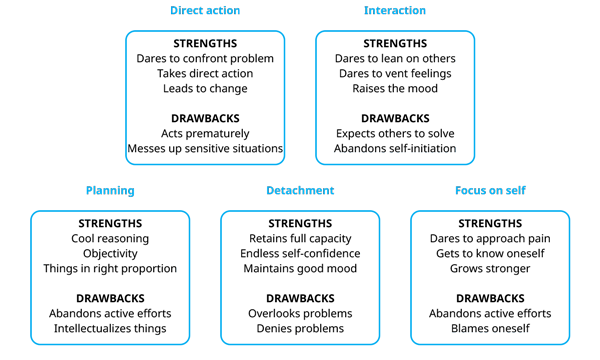< Lessons

The following concept of coping is based on stress and coping theories and factor analysis. The core is in five coping styles which comprise diverse single ways of coping, see figure below. Coaching of coping involves recognizing the individual's frequently used styles as important assets. The individual is then encouraged to use the less or not at all used styles and ways of coping.

Direct action means direct, unhesitating action upon the stressor or problem, "taking the bull by its horns". Direct action is considered a constructive style, focused on solving the problem. Instead of avoiding the problem the individual has the courage to confront the problem and attempt to influence or change the situation in some concrete way. Obviously, very strong and straightforward action may turn out to be less effective. In clearly ambiguous and sensitive situations such as involving interpersonal conflicts, it may be better first to refrain from strong action, examine the situation with a calm eye (cf. planning) and only then take on solution efforts.
Interaction means the ability to receive and actively seek support from others as well as express feelings of frustration to other people. Inability to use interaction reflects an exclusively self-relying, "tooth biting" style often related to the traditional male role. Interaction is targeted both at emotional control and problem solving. It lifts up and maintains the mood while also enhancing problem solving by providing concrete support from peers or close others. Obviously, exclusive emphasis on social interaction may also reflect excessive dependence on others in situations where direct action or calm planning would be more effective.
Planning means cool, rational analysis of the stress or problem situation and weighing of alternative solutions. Planning and perspective taking are almost always considered as constructive, problem solving styles of coping. It is always important to take an objective look at the situation and, instead of being driven by emotions, view the problem in its right proportions. Obviously, overemphasis or exclusive reliance on planning may lead to intellectualization or procrastination when direct action would be more effective.
Detachment means a tendency but also an ability to avoid excessive stress. Inability to detach oneself from problems has been viewed as an "occupational disease" of health and patient care professionals with the risk of ultimately burning out. It is a coping style focused on emotional control but, a reasonable amount of detachment enhances wellbeing. In other words, an individual should not hoard all the world's sorrows but be able to at least occasionally take a break from pressing timely problems. Obviously, overly strong detachment may indicate fleeing or denying problems which may in the longer run have unfavorable consequences.
Focus on oneself refers to the person's tendency in stressful problem situations to shift the attention to oneself. It is mainly a coping style serving the control of emotions but self-reflection may also have constructive, problem solving effects. It serves emotional control when the individual has given up the use of more proactive styles and shifts attention to oneself. In such a case, the individual may easily fall into self-denigration, blame him/herself for causing the problem, something that has been seen as more a characteristic of women than men. Constructive ends are served when the self-focus involves the brave encountering of painful issues. This can lead to enhanced self-understanding and generally stronger coping in problem situations. This is a central goal in psychotherapy.
Coaching of coping is initiated by presentation of the styles and concrete ways of coping for which this article serves as useful material to be sent in advance. The coaching discussion examines the most as well as least frequently used coping styles. The discussion runs on the level of the concrete ways of coping.
The individual may examine one's own styles of coping by rank ordering them with a self-assessment blank printable from here in PDF format. The actual coach-led sparring session begins noting of the most frequently used styles which are emphasized as existing valuable resources. However, the main goal is to encourage the person to increase the use of the unused or less used, underdeveloped styles of coping. The self-appraisal can also be compared to results derived from the WOPI Coping Styles questionnaire which produces a detailed measurement of the individual's coping.
Work wellbeing - ways of coping

Different stressful situations call for different ways of coping but individuals also tend to consistently use certain ways while failing to use other ways when facing stressful problem situations. The diverse ways of coping are organized under five coping styles, the identification and coaching of which helps the individual to cope with problems. Coping with stress has become a competency in itself along the disruptive changes currently taking place in work life.
The following concept of coping is based on stress and coping theories and factor analysis. The core is in five coping styles which comprise diverse single ways of coping, see figure below. Coaching of coping involves recognizing the individual's frequently used styles as important assets. The individual is then encouraged to use the less or not at all used styles and ways of coping.
Coping styles

Direct action
Direct action means direct, unhesitating action upon the stressor or problem, "taking the bull by its horns". Direct action is considered a constructive style, focused on solving the problem. Instead of avoiding the problem the individual has the courage to confront the problem and attempt to influence or change the situation in some concrete way. Obviously, very strong and straightforward action may turn out to be less effective. In clearly ambiguous and sensitive situations such as involving interpersonal conflicts, it may be better first to refrain from strong action, examine the situation with a calm eye (cf. planning) and only then take on solution efforts.
Interaction
Interaction means the ability to receive and actively seek support from others as well as express feelings of frustration to other people. Inability to use interaction reflects an exclusively self-relying, "tooth biting" style often related to the traditional male role. Interaction is targeted both at emotional control and problem solving. It lifts up and maintains the mood while also enhancing problem solving by providing concrete support from peers or close others. Obviously, exclusive emphasis on social interaction may also reflect excessive dependence on others in situations where direct action or calm planning would be more effective.
Planning
Planning means cool, rational analysis of the stress or problem situation and weighing of alternative solutions. Planning and perspective taking are almost always considered as constructive, problem solving styles of coping. It is always important to take an objective look at the situation and, instead of being driven by emotions, view the problem in its right proportions. Obviously, overemphasis or exclusive reliance on planning may lead to intellectualization or procrastination when direct action would be more effective.
Detachment
Detachment means a tendency but also an ability to avoid excessive stress. Inability to detach oneself from problems has been viewed as an "occupational disease" of health and patient care professionals with the risk of ultimately burning out. It is a coping style focused on emotional control but, a reasonable amount of detachment enhances wellbeing. In other words, an individual should not hoard all the world's sorrows but be able to at least occasionally take a break from pressing timely problems. Obviously, overly strong detachment may indicate fleeing or denying problems which may in the longer run have unfavorable consequences.
Focus on self
Focus on oneself refers to the person's tendency in stressful problem situations to shift the attention to oneself. It is mainly a coping style serving the control of emotions but self-reflection may also have constructive, problem solving effects. It serves emotional control when the individual has given up the use of more proactive styles and shifts attention to oneself. In such a case, the individual may easily fall into self-denigration, blame him/herself for causing the problem, something that has been seen as more a characteristic of women than men. Constructive ends are served when the self-focus involves the brave encountering of painful issues. This can lead to enhanced self-understanding and generally stronger coping in problem situations. This is a central goal in psychotherapy.
Coaching of coping
Coaching of coping is initiated by presentation of the styles and concrete ways of coping for which this article serves as useful material to be sent in advance. The coaching discussion examines the most as well as least frequently used coping styles. The discussion runs on the level of the concrete ways of coping.
The individual may examine one's own styles of coping by rank ordering them with a self-assessment blank printable from here in PDF format. The actual coach-led sparring session begins noting of the most frequently used styles which are emphasized as existing valuable resources. However, the main goal is to encourage the person to increase the use of the unused or less used, underdeveloped styles of coping. The self-appraisal can also be compared to results derived from the WOPI Coping Styles questionnaire which produces a detailed measurement of the individual's coping.
Lazarus, R. S., & Folkman, S. (1984). Stress, appraisal, and coping. New York: Springer.
Close
Helsinki (HQ)
Competence Dimensions LtdHelpdesk
GMT +3:00 - ± 1:00helpdesk(at)wopi.net